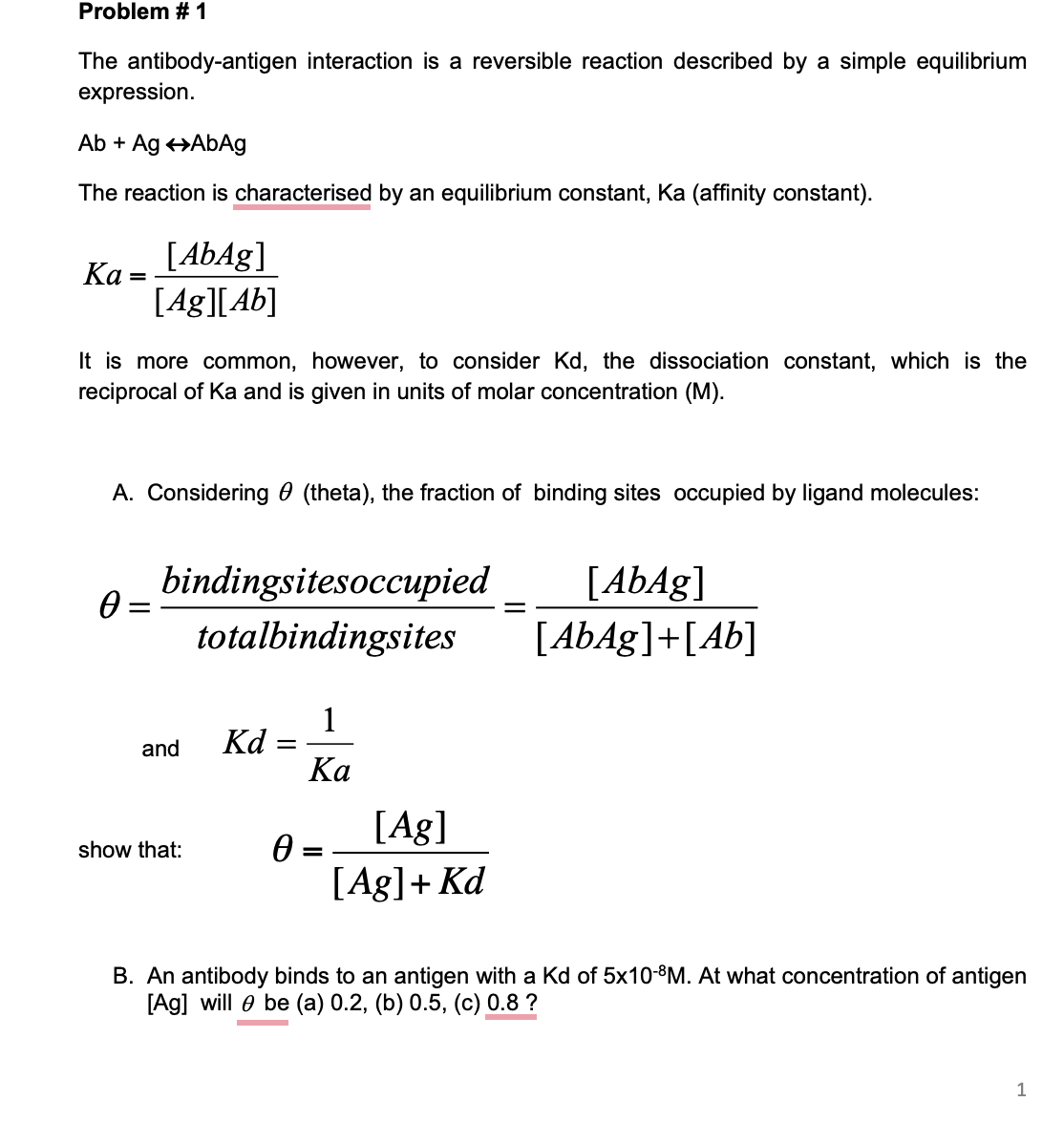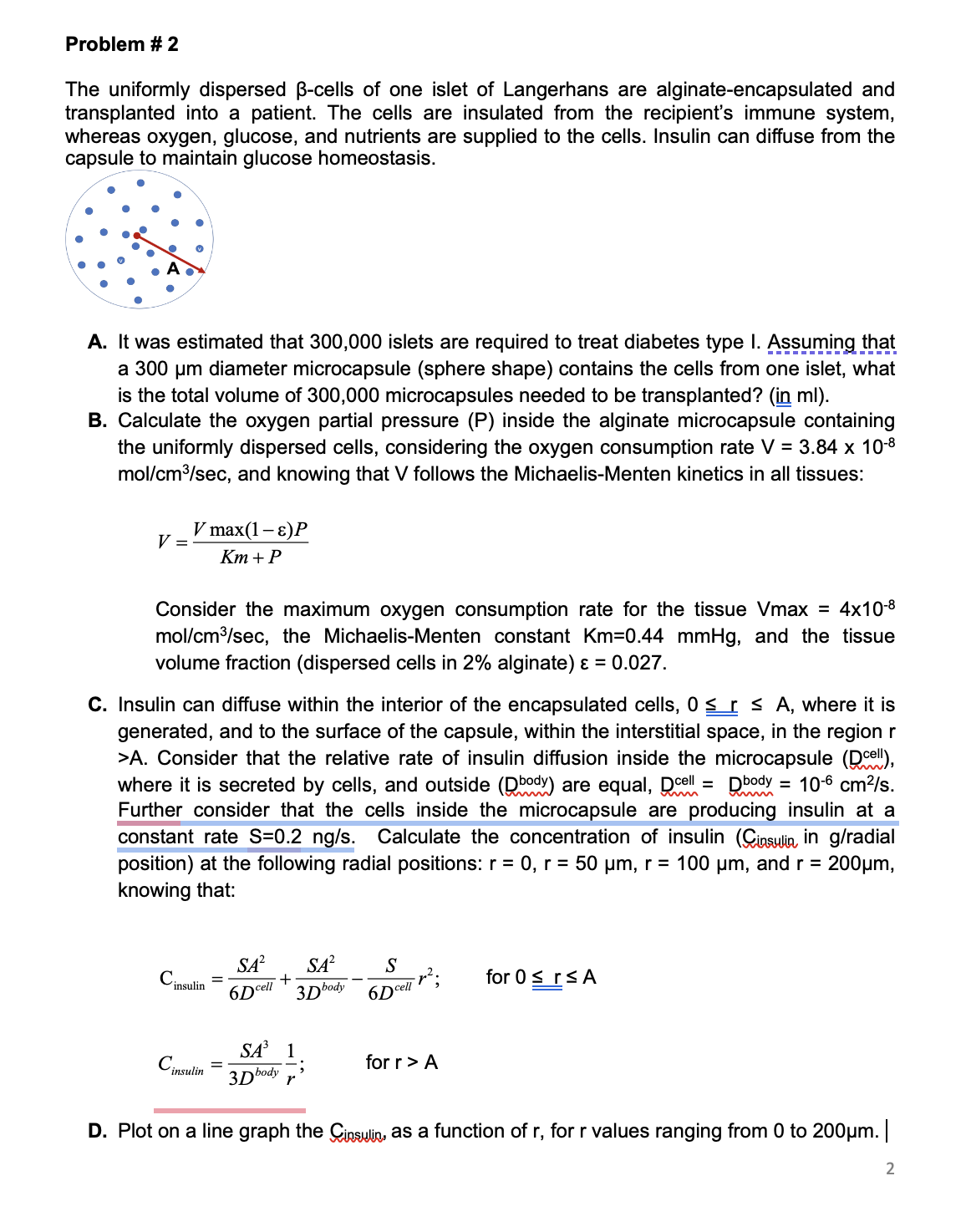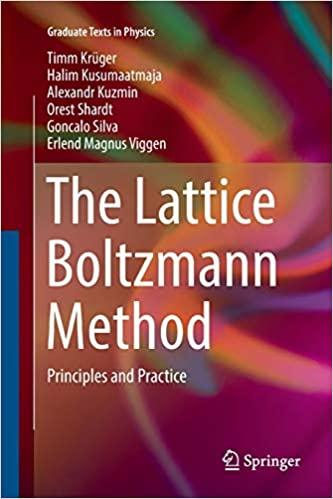Answered step by step
Verified Expert Solution
Question
1 Approved Answer
The antibody-antigen interaction is a reversible reaction described by a simple equilibrium expression. Ab+AgAbAg The reaction is characterised by an equilibrium constant, Ka (affinity constant).

 The antibody-antigen interaction is a reversible reaction described by a simple equilibrium expression. Ab+AgAbAg The reaction is characterised by an equilibrium constant, Ka (affinity constant). Ka=[Ag][Ab][AbAg] It is more common, however, to consider Kd, the dissociation constant, which is the reciprocal of Ka and is given in units of molar concentration (M). A. Considering (theta), the fraction of binding sites occupied by ligand molecules: =totalbindingsitesbindingsitesoccupied=[AbAg]+[Ab][AbAg] and Kd=Ka1 show that: =[Ag]+Kd[Ag] B. An antibody binds to an antigen with a Kd of 5108M. At what concentration of antigen [Ag] will be (a) 0.2 , (b) 0.5 , (c) 0.8 ? The uniformly dispersed -cells of one islet of Langerhans are alginate-encapsulated and transplanted into a patient. The cells are insulated from the recipient's immune system, whereas oxygen, glucose, and nutrients are supplied to the cells. Insulin can diffuse from the capsule to maintain glucose homeostasis. A. It was estimated that 300,000 islets are required to treat diabetes type I. Assuming that a 300m diameter microcapsule (sphere shape) contains the cells from one islet, what is the total volume of 300,000 microcapsules needed to be transplanted? (in ml ). B. Calculate the oxygen partial pressure (P) inside the alginate microcapsule containing the uniformly dispersed cells, considering the oxygen consumption rate V=3.84108 mol/cm3/sec, and knowing that V follows the Michaelis-Menten kinetics in all tissues: V=Km+PVmax(1)P Consider the maximum oxygen consumption rate for the tissue V max =4108 mol/cm3/sec, the Michaelis-Menten constant Km=0.44mmHg, and the tissue volume fraction (dispersed cells in 2% alginate) =0.027. C. Insulin can diffuse within the interior of the encapsulated cells, 0rA, where it is generated, and to the surface of the capsule, within the interstitial space, in the region r >A. Consider that the relative rate of insulin diffusion inside the microcapsule (Delil), where it is secreted by cells, and outside ( Dbody) are equal, Dcell=Dbody=106cm2/s. Further consider that the cells inside the microcapsule are producing insulin at a constant rate S=0.2ng/s. Calculate the concentration of insulin (Cinsulin in g/radial position) at the following radial positions: r=0,r=50m,r=100m, and r=200m, knowing that: Cinsulin=6DcellSA2+3DbodySA26DcellSr2;for0nACinsulin=3DbodySA3r1;forr>A D. Plot on a line graph the Cinsulin, as a function of r, for r values ranging from 0 to 200m. | The antibody-antigen interaction is a reversible reaction described by a simple equilibrium expression. Ab+AgAbAg The reaction is characterised by an equilibrium constant, Ka (affinity constant). Ka=[Ag][Ab][AbAg] It is more common, however, to consider Kd, the dissociation constant, which is the reciprocal of Ka and is given in units of molar concentration (M). A. Considering (theta), the fraction of binding sites occupied by ligand molecules: =totalbindingsitesbindingsitesoccupied=[AbAg]+[Ab][AbAg] and Kd=Ka1 show that: =[Ag]+Kd[Ag] B. An antibody binds to an antigen with a Kd of 5108M. At what concentration of antigen [Ag] will be (a) 0.2 , (b) 0.5 , (c) 0.8 ? The uniformly dispersed -cells of one islet of Langerhans are alginate-encapsulated and transplanted into a patient. The cells are insulated from the recipient's immune system, whereas oxygen, glucose, and nutrients are supplied to the cells. Insulin can diffuse from the capsule to maintain glucose homeostasis. A. It was estimated that 300,000 islets are required to treat diabetes type I. Assuming that a 300m diameter microcapsule (sphere shape) contains the cells from one islet, what is the total volume of 300,000 microcapsules needed to be transplanted? (in ml ). B. Calculate the oxygen partial pressure (P) inside the alginate microcapsule containing the uniformly dispersed cells, considering the oxygen consumption rate V=3.84108 mol/cm3/sec, and knowing that V follows the Michaelis-Menten kinetics in all tissues: V=Km+PVmax(1)P Consider the maximum oxygen consumption rate for the tissue V max =4108 mol/cm3/sec, the Michaelis-Menten constant Km=0.44mmHg, and the tissue volume fraction (dispersed cells in 2% alginate) =0.027. C. Insulin can diffuse within the interior of the encapsulated cells, 0rA, where it is generated, and to the surface of the capsule, within the interstitial space, in the region r >A. Consider that the relative rate of insulin diffusion inside the microcapsule (Delil), where it is secreted by cells, and outside ( Dbody) are equal, Dcell=Dbody=106cm2/s. Further consider that the cells inside the microcapsule are producing insulin at a constant rate S=0.2ng/s. Calculate the concentration of insulin (Cinsulin in g/radial position) at the following radial positions: r=0,r=50m,r=100m, and r=200m, knowing that: Cinsulin=6DcellSA2+3DbodySA26DcellSr2;for0nACinsulin=3DbodySA3r1;forr>A D. Plot on a line graph the Cinsulin, as a function of r, for r values ranging from 0 to 200m. |
The antibody-antigen interaction is a reversible reaction described by a simple equilibrium expression. Ab+AgAbAg The reaction is characterised by an equilibrium constant, Ka (affinity constant). Ka=[Ag][Ab][AbAg] It is more common, however, to consider Kd, the dissociation constant, which is the reciprocal of Ka and is given in units of molar concentration (M). A. Considering (theta), the fraction of binding sites occupied by ligand molecules: =totalbindingsitesbindingsitesoccupied=[AbAg]+[Ab][AbAg] and Kd=Ka1 show that: =[Ag]+Kd[Ag] B. An antibody binds to an antigen with a Kd of 5108M. At what concentration of antigen [Ag] will be (a) 0.2 , (b) 0.5 , (c) 0.8 ? The uniformly dispersed -cells of one islet of Langerhans are alginate-encapsulated and transplanted into a patient. The cells are insulated from the recipient's immune system, whereas oxygen, glucose, and nutrients are supplied to the cells. Insulin can diffuse from the capsule to maintain glucose homeostasis. A. It was estimated that 300,000 islets are required to treat diabetes type I. Assuming that a 300m diameter microcapsule (sphere shape) contains the cells from one islet, what is the total volume of 300,000 microcapsules needed to be transplanted? (in ml ). B. Calculate the oxygen partial pressure (P) inside the alginate microcapsule containing the uniformly dispersed cells, considering the oxygen consumption rate V=3.84108 mol/cm3/sec, and knowing that V follows the Michaelis-Menten kinetics in all tissues: V=Km+PVmax(1)P Consider the maximum oxygen consumption rate for the tissue V max =4108 mol/cm3/sec, the Michaelis-Menten constant Km=0.44mmHg, and the tissue volume fraction (dispersed cells in 2% alginate) =0.027. C. Insulin can diffuse within the interior of the encapsulated cells, 0rA, where it is generated, and to the surface of the capsule, within the interstitial space, in the region r >A. Consider that the relative rate of insulin diffusion inside the microcapsule (Delil), where it is secreted by cells, and outside ( Dbody) are equal, Dcell=Dbody=106cm2/s. Further consider that the cells inside the microcapsule are producing insulin at a constant rate S=0.2ng/s. Calculate the concentration of insulin (Cinsulin in g/radial position) at the following radial positions: r=0,r=50m,r=100m, and r=200m, knowing that: Cinsulin=6DcellSA2+3DbodySA26DcellSr2;for0nACinsulin=3DbodySA3r1;forr>A D. Plot on a line graph the Cinsulin, as a function of r, for r values ranging from 0 to 200m. | The antibody-antigen interaction is a reversible reaction described by a simple equilibrium expression. Ab+AgAbAg The reaction is characterised by an equilibrium constant, Ka (affinity constant). Ka=[Ag][Ab][AbAg] It is more common, however, to consider Kd, the dissociation constant, which is the reciprocal of Ka and is given in units of molar concentration (M). A. Considering (theta), the fraction of binding sites occupied by ligand molecules: =totalbindingsitesbindingsitesoccupied=[AbAg]+[Ab][AbAg] and Kd=Ka1 show that: =[Ag]+Kd[Ag] B. An antibody binds to an antigen with a Kd of 5108M. At what concentration of antigen [Ag] will be (a) 0.2 , (b) 0.5 , (c) 0.8 ? The uniformly dispersed -cells of one islet of Langerhans are alginate-encapsulated and transplanted into a patient. The cells are insulated from the recipient's immune system, whereas oxygen, glucose, and nutrients are supplied to the cells. Insulin can diffuse from the capsule to maintain glucose homeostasis. A. It was estimated that 300,000 islets are required to treat diabetes type I. Assuming that a 300m diameter microcapsule (sphere shape) contains the cells from one islet, what is the total volume of 300,000 microcapsules needed to be transplanted? (in ml ). B. Calculate the oxygen partial pressure (P) inside the alginate microcapsule containing the uniformly dispersed cells, considering the oxygen consumption rate V=3.84108 mol/cm3/sec, and knowing that V follows the Michaelis-Menten kinetics in all tissues: V=Km+PVmax(1)P Consider the maximum oxygen consumption rate for the tissue V max =4108 mol/cm3/sec, the Michaelis-Menten constant Km=0.44mmHg, and the tissue volume fraction (dispersed cells in 2% alginate) =0.027. C. Insulin can diffuse within the interior of the encapsulated cells, 0rA, where it is generated, and to the surface of the capsule, within the interstitial space, in the region r >A. Consider that the relative rate of insulin diffusion inside the microcapsule (Delil), where it is secreted by cells, and outside ( Dbody) are equal, Dcell=Dbody=106cm2/s. Further consider that the cells inside the microcapsule are producing insulin at a constant rate S=0.2ng/s. Calculate the concentration of insulin (Cinsulin in g/radial position) at the following radial positions: r=0,r=50m,r=100m, and r=200m, knowing that: Cinsulin=6DcellSA2+3DbodySA26DcellSr2;for0nACinsulin=3DbodySA3r1;forr>A D. Plot on a line graph the Cinsulin, as a function of r, for r values ranging from 0 to 200m. | Step by Step Solution
There are 3 Steps involved in it
Step: 1

Get Instant Access to Expert-Tailored Solutions
See step-by-step solutions with expert insights and AI powered tools for academic success
Step: 2

Step: 3

Ace Your Homework with AI
Get the answers you need in no time with our AI-driven, step-by-step assistance
Get Started


